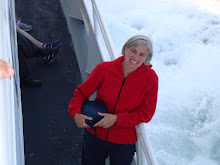KN: How did you come up with the idea for the series RAINBOW OF ANIMALS?
MS: This series started with a question from my editor: Did I think we could do an interesting group of books about animal colors? I did some research and discovered that an animal’s color is often critical to its survival.
Golden monkeys live in dense mountain forests. If they didn’t have blue faces, they’d have trouble spotting one another. A monarch butterfly’s bright orange wings warn enemies that they are poisonous. I couldn’t believe all the interesting color-related stories I found. I knew we could create some great books for kids.
At first, we were calling the series Colors in Nature. I was researching all kinds of colors, including black, white, pink, and brown. Then, during a brainstorming phone call, either my editor or I (we can’t remember who) blurted out “Animals of the Rainbow.” We both liked it, but the idea of writing a whole book about purple animals made me nervous. Were there enough good examples? Could we find photos? I did some research and found out that there are more purple animals than you might think—especially in the ocean. So we settled on six books, one for each color of the rainbow. Over time, the series name switched to Rainbow of Animals.
I was originally thinking of writing books for grades 2-4, but my editor wanted to go younger. So we did. To make books that would appeal to early readers, I knew the text would need to be simple and fascinating.
I decided to start off by inviting readers to look at the colors of animals in their immediate surroundings. Then I shared fascinating animal stories from around the world. The book ends with a game in which children use what they have just learned to guess how two animals depend on their coloring. Finally, a page maps of shows where each of the animals discussed in the book lives. This structure took a while to work out and involved a lot of collaborative discussions with my editor.
Once we both felt great about the concept, she took my proposal to the acquisitions committee, and it was approved. Then it was time to really get to work.
KN: Describe your research process for this set of books.
MS: For most of the books I write, I submit the text and the publisher takes care of the photos. But for this series, the photos had to be the starting point. So I did the photo research myself, looking for images that were beautiful, fit the books’ format, and showed animals with interesting color-related stories.
I did the photo research and the informational research simultaneously, back and forth, back and forth. I gathered some great stories. Then I looked for images. Sometimes I found great images, and then looked to see how the animal depended on its coloring. I needed both—a great image and a great story. Sometimes I found matches, and sometimes I didn’t. I kept up this process until I had enough examples for each book.
KN: Which book in the series did you write first, and how long did it take you to write it? After completing the first book, was it easier to write the rest of the book in the series?
MS: I may sound crazy, but I wrote all the books at the same time. I often write several books simultaneously when I’m trying to maintain a particular voice and style and reading level. Around this time, I was also working on a series called Gross & Goofy Body. It has a very different voice and it’s for older kids, so I had to immerse myself in one project or the other for chunks of time.
Because I’m usually working on several projects at once and I have to juggle writing and researching with things like marketing and preparing for school visits and developing new ideas, I can never really say how long it takes to write a particular book. (People ask me that question all the time.) I work on things a little at a time over a period of months or even years.
I think I finished Why Are Animals Red? first. Thanks to Kodachrome 64 film (a popular professional-quality film that tends to bring out reds), there were lots of great images to choose from. I know I finished Why Are Animals Purple? last because I really wanted to include the purple heron, but I just couldn’t find a good image in a horizontal format. In the end, the clever designer saved the day. He found a way to make a vertical image work in the layout. Making books really is a very collaborative process.
KN: You've spent lots of time outside, and you've traveled to many different places. Have you seen any of the animals in these books in person? If so, please tell us about your encounters.
MS: Wow, that’s a great question. I knew before I even started Why Are Animals Blue? that I wanted to include the blue darner dragonfly, an insect that’s very common in
I also knew I had to include the blue-footed boobie, an adorable bird I saw when I was in the
KN: Is there anything else you'd like to tell us?
MS: If anyone would like to learn more about me or my books, I hope they will take a look at my website: www.melissa-stewart.com. I also started a blog recently. Celebrate Science http://celebratescience.blogspot.com/ includes all kinds of fun activities that you can do with kids as well as tips for writing nonfiction.
Thanks so much for interviewing me, Kate. It’s been a lot of fun.
You’re welcome, Melissa. It’s been fun for me, too.

No comments:
Post a Comment